WiGig Market Size
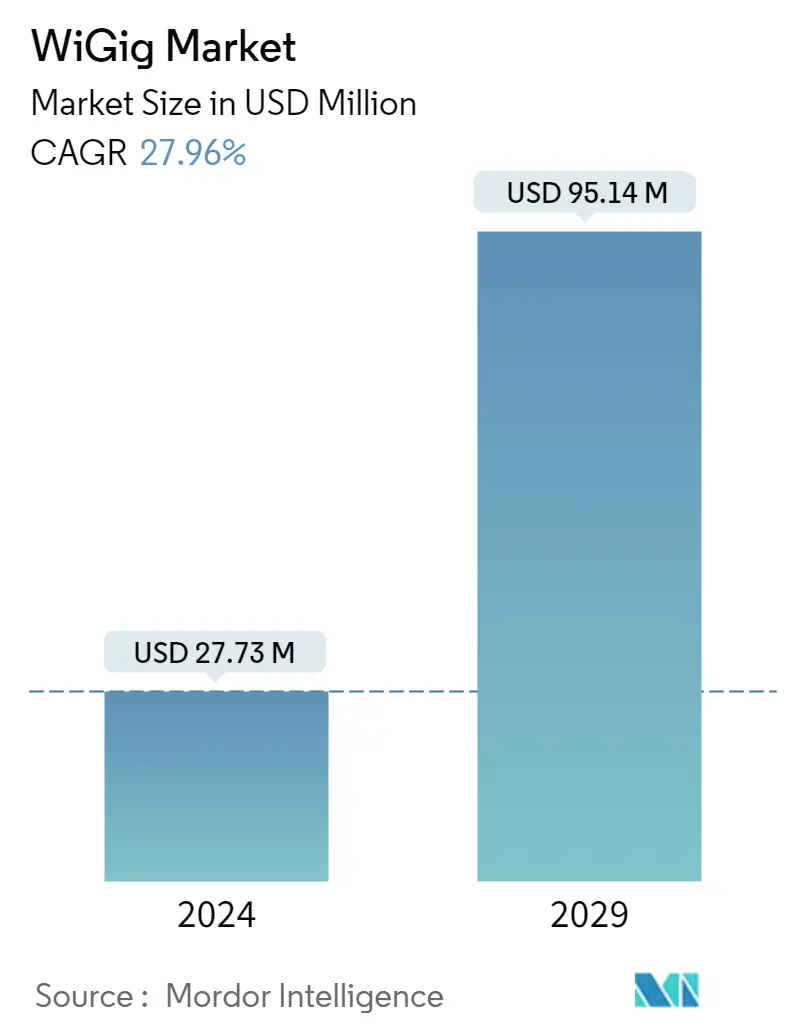
| Study Period | 2019 - 2029 |
| Market Size (2024) | USD 27.73 Million |
| Market Size (2029) | USD 95.14 Million |
| CAGR (2024 - 2029) | 27.96 % |
| Fastest Growing Market | Asia Pacific |
| Largest Market | North America |
Major Players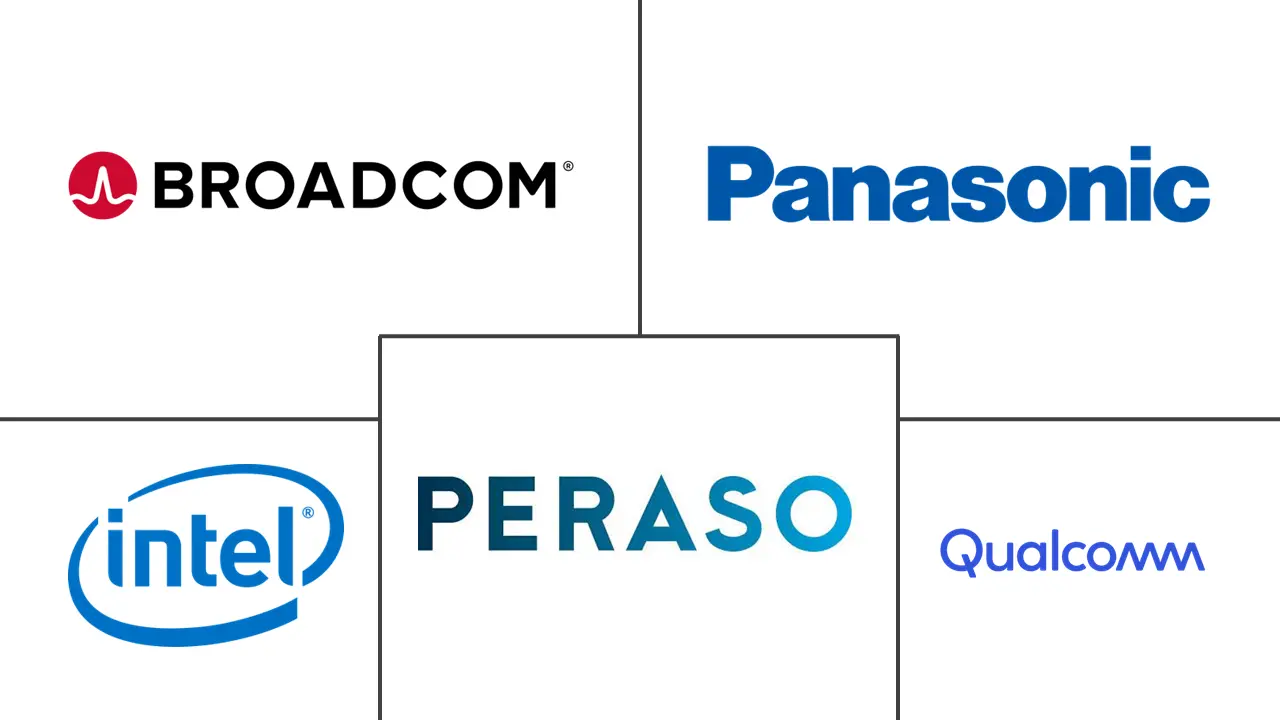
*Disclaimer: Major Players sorted in no particular order |
Need a report that reflects how COVID-19 has impacted this market and its growth?
WiGig Market Analysis
The WiGig Market size is estimated at USD 27.73 million in 2024, and is expected to reach USD 95.14 million by 2029, growing at a CAGR of 27.96% during the forecast period (2024-2029).
The factors driving the growth of the Wireless Gigabit Market include an increase in bandwidth demand, a saturation of smartphones, and the use of various devices, all of which contribute to the overall industry development. Furthermore, rising IT spending and shifting budget distributions in emerging economies drive demand for technically advanced items to support the current initiative infrastructure.
- Public Wi-Fi contributes to various smart city goals, including bridging the digital divide, allowing Internet of Things (IoT)-based city services, and offering amenities for residents, students, visitors, and tourists. This, together with increased investments in smart city improvements by government agencies from various nations, is one of the primary reasons driving the market growth. Apart from that, WiGig devices are used in many enterprises to allow employees to finish work from various devices without the burden of a cable connection.
- They are also used for effective in-office networking, moving huge files, seamlessly running bandwidth-intensive programs, and projecting visuals and audio on a wide screen in a conference room or auditorium with very low latency. WiGig products are also used in handy public kiosk services and wireless docking between devices such as cellphones, laptops, projectors, and tablets. They are also frequently used for high-definition (HD) movie downloads, simultaneous streaming of multiple ultra-HD videos, and immersive gaming, augmented reality (AR), and virtual reality (VR) experiences. This, together with rising consumer expenditure on digital media, is fueling industry expansion.
- The growing preference for BYOD policies among organizations operating in various end-use industries is creating a considerable demand for WiGig, which will drive the market in the future. This shift toward BYOD allows enterprises to increase their IT infrastructure budgets to improve network speed. The rising usage of mobile phones, laptops, desktop computers, and other electronic devices at work is creating a major reliance on high bandwidth and internet speed to support the many apps and services. Furthermore, the growing necessity for a high-speed internet connection to speed up applications and work-related activities is fueling market expansion.
- Technological constraints are the main issue confronting industry participants in the worldwide WiGig market. The current technology operates at frequencies over 60Hz; however, the frequencies employed in contemporary Wi-Fi products are only between 2.4 and 5 GHz. As a result, there is a need to upgrade the current infrastructure, which will need a significant capital commitment from customers.
- Working from home has become a megatrend during the pandemic days. The speed of the shift to large-scale remote work has resulted in the use of personal devices, including mobile phones, laptops, tablets, desktops, etc. Employees are also observed using personal Wi-Fi and internet connections to access the corporate network. Moreover, in the post COVID-19 scenario, the market boosted Wi-Fi use to keep businesses and critical functions operational.
WiGig Market Trends
Gaming and Multimedia Expected to Drive the Market
- The more complex online multiplayer games educate players on strategically and analytically assessing risk and reward. These games require young players to react fast to game changes. Children gain from this game because the abilities learned can be applied to real-world careers that require problem-solving, analytical skills, and strategic thinking. Games may be a terrific method for children to learn about diverse ideas and cultures since they allow them to immerse themselves in virtual worlds and, at times, communicate with people from all over the world. Such trends would raise the demand for the wireless gigabit market in gaming.
- In recent years, the internet ecosystem has initiated course correction by end-to-end local game development. For instance, Zynga's shift from social to mobile meant several tough years, but in February 2022, it reported Q4 revenue of USD 727 million, up by 52% year-over-year. It launched its free game Farmville-3 in June 2019, but the Flash-based game created by Zynga was primarily designed to be played within Facebook.
- According to the Mobile Video Industry Council, mobile operators expected cloud gaming to represent 25-50% of 5G data traffic by 2022, owing to the quick progression of cloud gaming services in recent months. Over-the-top (OTT) players also have ambitious plans to become the 'Netflix for gaming,' hosting libraries of thousands of immediately accessible games that will ultimately consume three to four times the amount of bandwidth on 5G networks compared to standard definition video traffic. Such high bandwidth will require the use of WiGig in coming future.
- Additionally, According to Microsoft, Microsoft's online gaming service had around 120 million monthly active users as of December 2022, up from just under 40 million at the start of 2016. The service was previously known as Xbox Live until being rebranded as Xbox Network in March 2023 to distinguish it from the Xbox Live Gold subscription service offering. Such a rise in demand for online consoles is expected to drive the studied market.
- Furthermore, In January 2023, the Razer Edge will be available in the United States through Verizon. The Razer Edge is powered by a Snapdragon G3x Gen 1 processor, which appears to be based on the Snapdragon 888. The 6.8" AMOLED display with 2,400 x 1,080px resolution (20:9) and 144Hz refresh rate provides it an advantage (heh) over the likes of the Steam Deck and the Nintendo Switch. In comparison, the Switch OLED has a 7-inch display, and the Steam Deck has a 7-inch LCD, but both feature just 720p resolution and run at 60Hz.
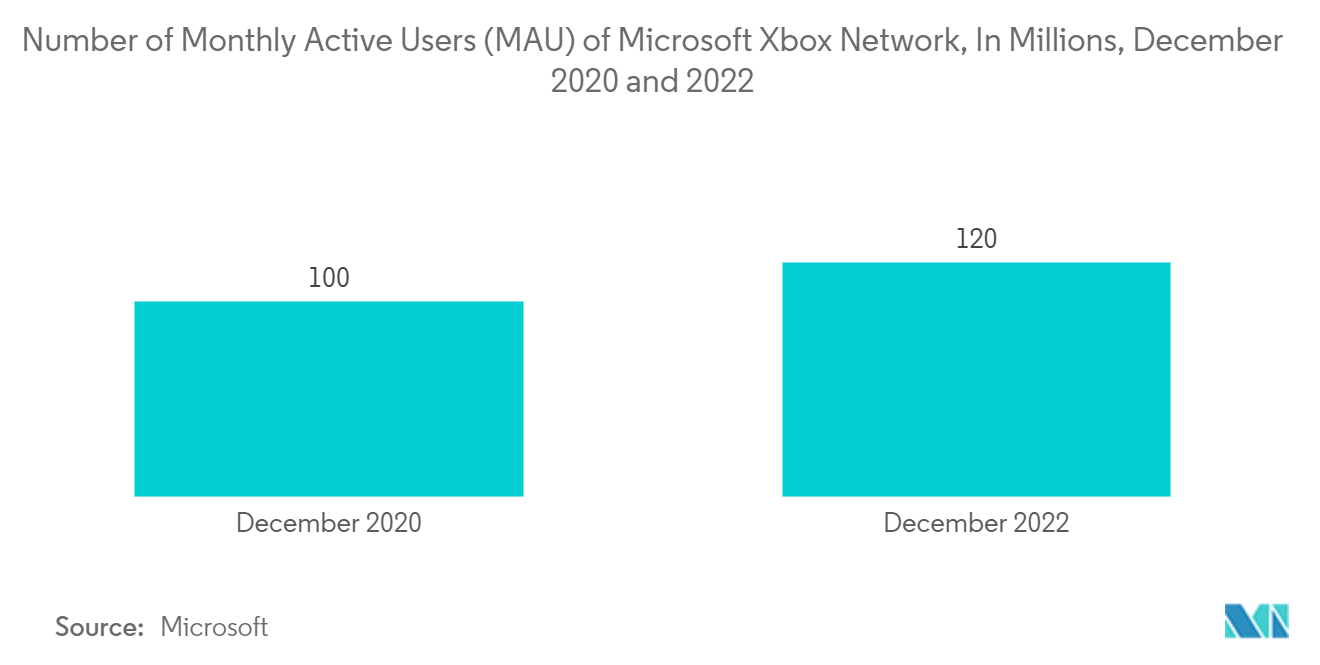
Asia-Pacific is Expected to Register the Highest Market Growth
- IEEE 802.11aj, an amendment to IEEE 802.11TM that specifies the Physical (PHY) layer and the Medium Access Control (MAC) layer in the 60 GHz and 45 GHz bands to accommodate expanding high-speed wireless LAN capacity demands in China, was authorized by IEEE and the IEEE Standards Association (IEEE-SA). The standard modification defines four 1.08 GHz channels in the 60 GHz band to support low-power devices with high data rates and broader coverage areas, as well as 5 GHz of new bandwidth in the 45 GHz band with up to a 15 Gb/s data rate. This enhances the capabilities of IEEE 802.11, the foundation of Wi-Fi networking equipment.
- In September 2022, Fujikura Ltd. developed and began distributing samples of a 60 GHz millimeter-wave wireless communication module that may be independently verified for Technical Regulations Conformity Certification in Japan, which does not require a license. The newly developed 60 GHz band millimeter-wave wireless communication module's structure has been upgraded and optimized to qualify for Technical Regulations Conformity Certification. This module will be provided with a certifying body's Technical Rules Conformity Certification mark. Its pre-certification greatly simplifies the development of communication and industrial equipment with the module.
- In February 2022, Nippon Telegraph and Telephone Corporation, Japan implemented 60-GHz band wireless LAN (WiGig) for the first time globally, achieving uninterrupted large-capacity wireless transmission in high-speed mobility situations using terminal-driven dynamic site diversity control technology. NTT's terminal-driven dynamic site diversity control technology enables even non-mobile wireless communication systems like WiGig to achieve continuous high-capacity wireless connections to high-speed mobile terminals. It can be utilized for real-time video transmission from drones and autos and batch data transmission.
- Similarly, recently, the ITU-APT Foundation of India (IAFI), a telecom industry organization, has pushed to delicense spectrum in the V-band (60 GHz range), allowing it to be granted without auctions and so keeping costs low, thereby aiding in the government's 'WiFi-for-all' effort to bridge the digital divide. Additionally, new technologies in the 60 GHz band (57-64 GHz) can achieve cost points an order of magnitude lower than existing fiber while providing fiber-like reliability and multigigabit speeds. Certain new 60 GHz band technologies can offer cost savings of one or two orders of magnitude over fiber and conventional milli-metric band backbone networks.
- The rising understanding of the benefits of phased array antenna and electronic beam-steering technology among operators and equipment makers is now translating into a debate among regulatory committees. Lattice recently participated in a technical analysis conducted by Huawei that forms the basis of a multi-company proposal to the Fixed Service working group in CEPT (ECC SE 19) advocating regulatory reform as part of this effort. Lattice provided the system parameters for their current wireless infrastructure solution, allowing Huawei to simulate the propagation characteristics and interference probability in an urban deployment simulation.
- The only way to wirelessly stream high quality, low latency 4K video across devices is at 60 GHz. Other wireless solutions must drastically compress 4K video, resulting in a lower quality and higher latency video experience. There aren't any cords. 60 GHz enables for smooth wireless communications between devices, removing the need for obtrusive cords and wires. The 60 GHz spectrum has 7 GHz of bandwidth, which provides the required capacity for the expanding number of Internet-connected devices. The amount of data that individuals utilize and the number of linked gadgets will only grow. The 60 GHz band can handle more data and connections while providing a better user experience.
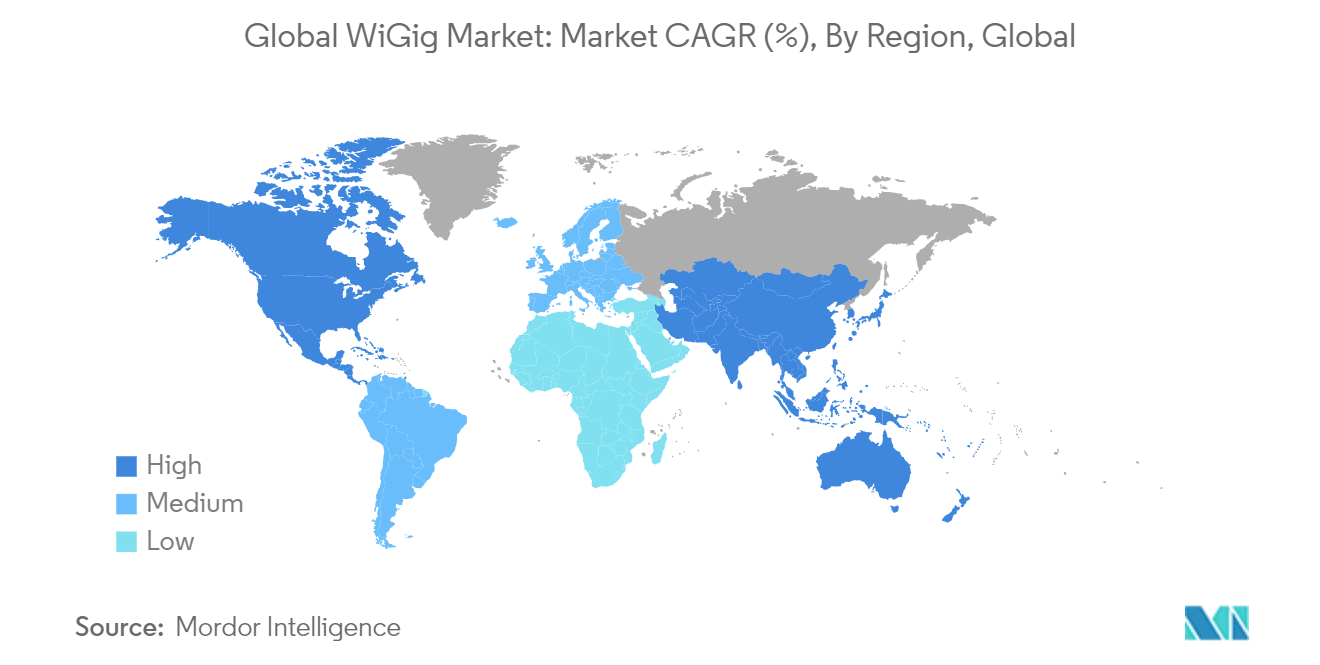
WiGig Industry Overview
The WiGig market is fragmented in nature, as the global players are competing to innovate the technology to remove the market challenges, which can hamper the current growth. The key players are Intel Corporation, Panasonic Corporation, and Qualcomm Technologies Inc., among others.
- October 2023: Tarana Wireless, Inc. announced that its advanced fixed wireless access (ngFWA) platform, Gigabit 1, has the capability to operate in the expansive new unlicensed 6 GHz spectrum that will soon be accessible in the United States. Numerous public and private organizations in the country are currently dedicating their efforts to addressing the ongoing broadband challenges.
- November 2023: Cambium Networks, a networking solutions provider, announced that Nextlink Internet has made a substantial order to enhance its coverage area with the advanced ePMP 6 GHz fixed wireless broadband solution. Nextlink intends to utilize ePMP primarily to connect remote areas in low-density rural regions. This strategic investment in Cambium Networks solutions will greatly enhance gigabit fixed wireless accessibility, benefiting numerous rural and suburban residents throughout the American heartland.
WiGig Market Leaders
Panasonic Corporation
Qualcomm Technologies, Inc.
Intel Corporation
Broadcom Inc.
Peraso Technologies, Inc.
*Disclaimer: Major Players sorted in no particular order
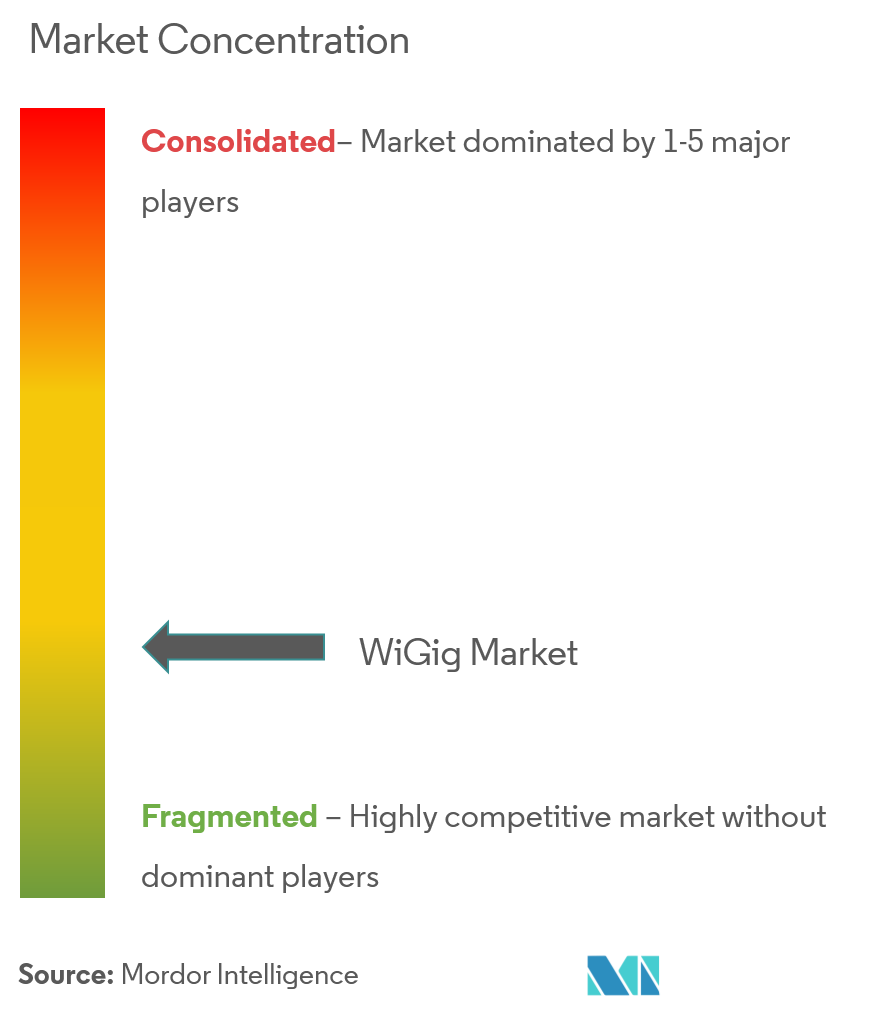
WiGig Market News
- October 2023: ZTE is currently working on developing gigabit broadband and expanding smart home applications. ZTE strongly believes that users will inevitably choose gigabit-to-the-home, gigabit Wi-Fi, and gigabit networking to enjoy a high-speed internet experience fully. To enhance user satisfaction and introduce new services, ZTE recognizes the need for technical improvements in bandwidth, coverage, and management of cloud platforms. Wi-Fi performance is crucial for achieving gigabit connectivity, and ZTE sees the Wi-Fi 6 technology as suitable for scenarios that require large bandwidth, low latency, and wide connection. ZTE also foresees continued growth in the Americas of the Wi-Fi 6 market share.
- August 2023: Australian Internet Service Provider Move Up Internet (MUI) has announced its intention to introduce an Internet service created by Meta, the parent company of Facebook. Through this service, MUI aims to provide residents and businesses in the Sunshine Coast region of Australia with gigabit Internet. Utilizing Meta's advanced Terragraph technology, MUI plans to extend coverage from Noosa to Tweed Heads in Southeast Queensland, offering a variety of Internet options directly to customers, eliminating the need to resell NBN services.
WiGig Market Report - Table of Contents
1. INTRODUCTION
1.1 Study Assumptions and Market Definition
1.2 Scope of the Study
2. RESEARCH METHODOLOGY
3. EXECUTIVE SUMMARY
4. MARKET INSIGHTS
4.1 Market Overview
4.2 Industry Attractiveness - Porter's Five Forces Analysis
4.2.1 Bargaining Power of Suppliers
4.2.2 Bargaining Power of Buyers
4.2.3 Threat of New Entrants
4.2.4 Threat of Substitutes
4.2.5 Intensity of Competitive Rivalry
4.3 Industry Value Chain Analysis
4.4 Assessment of Impact of Covid-19 on the Industry
5. MARKET DYNAMICS
5.1 Market Drivers
5.1.1 Growing Technological Advancements in the Communications Industry
5.1.2 Rising Adoption of High-resolution Videos
5.2 Market Restraints
5.2.1 Shorter Operating Range of WiGig Products
6. TECHNOLOGY SNAPSHOT
7. MARKET SEGMENTATION
7.1 Product
7.1.1 Display Devices
7.1.2 Network Infrastructure Devices
7.2 Application
7.2.1 Gaming and Multimedia
7.2.2 Networking
7.2.3 Other Applications
7.3 Geography
7.3.1 North America
7.3.2 Europe
7.3.3 Asia-Pacific
7.3.4 Rest of the World
8. COMPETITIVE LANDSCAPE
8.1 Company Profiles
8.1.1 Panasonic Corporation
8.1.2 Qualcomm Technologies Inc.
8.1.3 Intel Corporation
8.1.4 Broadcom Inc.
8.1.5 Peraso Technologies Inc.
8.1.6 Blu Wireless Technology Limited
8.1.7 Tensorcom Inc.
8.1.8 Fujikura Ltd
8.1.9 Sivers Ima Holding AB
8.1.10 Cisco Systems Inc.
8.1.11 Dell Technologies Inc.
8.1.12 Lenovo Group Limited
8.1.13 HP Development Company LP
- *List Not Exhaustive
9. INVESTMENT ANALYSIS
10. FUTURE OF THE MARKET
WiGig Industry Segmentation
WiGig, also known as 60 GHz Wi-Fi, refers to a set of 60 GHz wireless network protocols. It enables high-performance wireless data, display, and audio applications. WiGig transfers data wirelessly on the 60 GHz frequency, unlike Wi-Fi 6 and other normal versions of Wi-Fi that use the 2.4 GHz or 5 GHz frequencies. The study covers the market based on product type and application in different sectors worldwide.
The WiGig market is segmented by product (display devices and network infrastructure devices), by application (gaming and multimedia, networking, and other applications), and by geography (North America, Europe, Asia-Pacific, and Rest of the World). The market sizes and forecasts are provided in terms of value (USD) for all the above segments.
| Product | |
| Display Devices | |
| Network Infrastructure Devices |
| Application | |
| Gaming and Multimedia | |
| Networking | |
| Other Applications |
| Geography | |
| North America | |
| Europe | |
| Asia-Pacific | |
| Rest of the World |
WiGig Market Research FAQs
How big is the WiGig Market?
The WiGig Market size is expected to reach USD 27.73 million in 2024 and grow at a CAGR of 27.96% to reach USD 95.14 million by 2029.
What is the current WiGig Market size?
In 2024, the WiGig Market size is expected to reach USD 27.73 million.
Who are the key players in WiGig Market?
Panasonic Corporation, Qualcomm Technologies, Inc., Intel Corporation, Broadcom Inc. and Peraso Technologies, Inc. are the major companies operating in the WiGig Market.
Which is the fastest growing region in WiGig Market?
Asia Pacific is estimated to grow at the highest CAGR over the forecast period (2024-2029).
Which region has the biggest share in WiGig Market?
In 2024, the North America accounts for the largest market share in WiGig Market.
What years does this WiGig Market cover, and what was the market size in 2023?
In 2023, the WiGig Market size was estimated at USD 21.67 million. The report covers the WiGig Market historical market size for years: 2019, 2020, 2021, 2022 and 2023. The report also forecasts the WiGig Market size for years: 2024, 2025, 2026, 2027, 2028 and 2029.
WiGig Industry Report
Statistics for the 2024 WiGig market share, size and revenue growth rate, created by Mordor Intelligence™ Industry Reports. WiGig analysis includes a market forecast outlook to 2029 and historical overview. Get a sample of this industry analysis as a free report PDF download.
